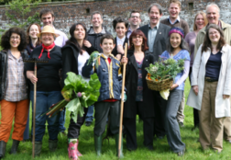Keele University is situated in 250 ha of landscaped grounds to the west of the Potteries conurbation in North Staffordshire, UK and has a wide variety of flora and fauna. Some of this variety, e.g. the birds, has been well-studied. Much of this accumulated knowledge is available on the University arboretum website. Staff, students and visitors are encouraged to explore the different areas of the campus with the help of a guided walk leaflet and other natural history booklets available. Guided ‘lunch-time’ walks are also on offer and updates of sightings and activity are updated via a blog and on twitter.
Keele University’s strategic plan holds environmental sustainability at the heart of the vision and values that defines the institution. Keele aims “To promote environmental sustainability in all that we do” and Biodiversity is identified as a key theme within the sustainability strategy. Whilst the University is gifted with a campus rich in variety of fauna and flora, we feel that further improvements can be made to improve biodiversity by looking for viable opportunities to enhance the number and abundance of existing and new appropriate species, to secure their long-term future within the Estate.
There can be challenges in coordinating the desires and aspirations of sustaining and enhancing the fauna and flora on campus, with the need to develop the built environment. Keele University have established the Natural Estates Advisory Group (NEAG), represented by academic experts and estates management and report directly into University senior management. The group enables estate planning to include complementary plans which align building development with a natural sustainable campus and academic priorities. The group is responsible for coordinating the management and improvements to biodiversity on campus whilst looking for opportunities to increase the use of the campus within our educational programmes and research. Students are encouraged to input into Biodiversity Plans by undertaking biodiversity research projects specific to the campus. One recent example is a master’s thesis which looked at the spatial distributions and conservation of bats on campus.
Our role as an educational institution is not confined to our lecture theatres and we believe that the physical environment can play an important role in normalising good environmental practice both for our staff and students, and this can have an impact on how staff and students act when off campus. Biodiversity initiatives are a crucial way to engage students and staff in sustainable development. One established initiative is the Keele organic allotments that engage staff, students and the local community with the land and each other in a sustainable way. Working alongside the Student Union volunteering and local and national conservation charities a number of new initiatives are planned to meet our Biodiversity Action Plan targets, including the installation of bat boxes.
We will measure success in number of biodiversity initiatives implemented and number of staff and students engaged.






 Except where otherwise stated, content on this site is
licensed under a Creative Commons Attribution 3.0 License.
Except where otherwise stated, content on this site is
licensed under a Creative Commons Attribution 3.0 License.
